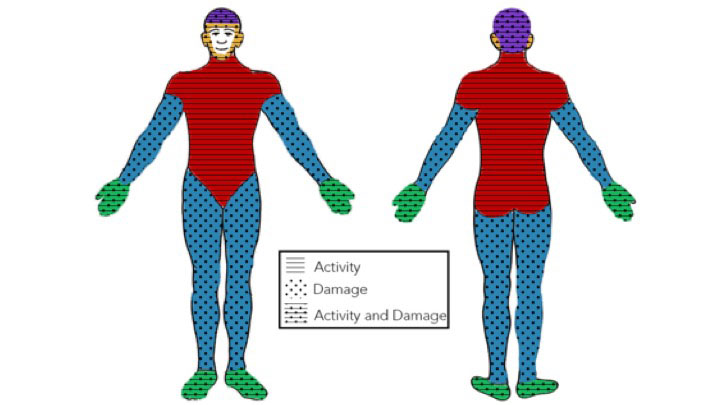Session Information
Date: Tuesday, November 12, 2019
Title: Miscellanous Rheumatic & Inflammatory Disease Poster III: Autoimmune Conditions and Therapies
Session Type: Poster Session (Tuesday)
Session Time: 9:00AM-11:00AM
Background/Purpose: Cutaneous lupus erythematosus (CLE) has multiple subtypes that account for a broad range of presentations. The preferential locations of skin lesions have only been described based on clinical experience, and statistical approaches are lacking. The principal component analysis is a dimension reducing test that seeks to describe variability amongst observed, correlated variables through a set of latent, or unobserved, variables called factors.1 We propose that an analysis of this type will better characterize CLE subtypes in an objective way, particularly with regards to clinical aspects and location of skin lesions.
Methods: We conducted a cross-sectional analysis of patients enrolled in the Cutaneous Lupus Registry at the University of Texas Southwestern Medical Center from November 2008 to July 2018. Components of the Cutaneous Lupus Erythematosus Disease Area and Severity Index (CLASI) were scored by one dermatologist (BFC) for 303 patients. We then ran a principal components analysis on these patients using IBM SPSS v. 25.
Results: Our results showed that around half of the variance was explained in the first five factors alone (F1 through F5). The factors correlated with well-known subtypes. F1 delineated patients with high CLASI activity scores in the neck, chest, arms and back, and resembled patients with subacute CLE, based on the trunk and arm preference with high activity scores (Figure 1, red). F2 described patients with high CLASI damage scores on the scalp, ears and face (Figure 1, orange). while F3 characterized patients with damage on the posterior neck, back/buttocks, arms and legs (Figure 1, blue). Because of their predilection for higher damage scores, F2 and F3 resembled localized and generalized discoid lupus, respectively. F4 characterized damage only predominately on acral surfaces, favoring chilblains lupus (Figure 1, green). F5 described patients with activity and damage in the scalp, which could resemble patients with discoid lupus limited to involvement of the scalp (Figure 1, purple).
Conclusion: ). The principal component analysis helps characterize where on the body lesions of CLE tend to occur, in terms of activity and damage, in certain patient demographics. These results further clinical knowledge about the nature of CLE lesions, and may help guide clinical decisions in the future.
To cite this abstract in AMA style:
Prasad S, Raman J, Ogunsanya M, Chong B. Principal Components Analysis as a Tool to Identify Lesional Skin Patterns in Cutaneous Lupus Erythematosus [abstract]. Arthritis Rheumatol. 2019; 71 (suppl 10). https://acrabstracts.org/abstract/principal-components-analysis-as-a-tool-to-identify-lesional-skin-patterns-in-cutaneous-lupus-erythematosus/. Accessed .« Back to 2019 ACR/ARP Annual Meeting
ACR Meeting Abstracts - https://acrabstracts.org/abstract/principal-components-analysis-as-a-tool-to-identify-lesional-skin-patterns-in-cutaneous-lupus-erythematosus/

